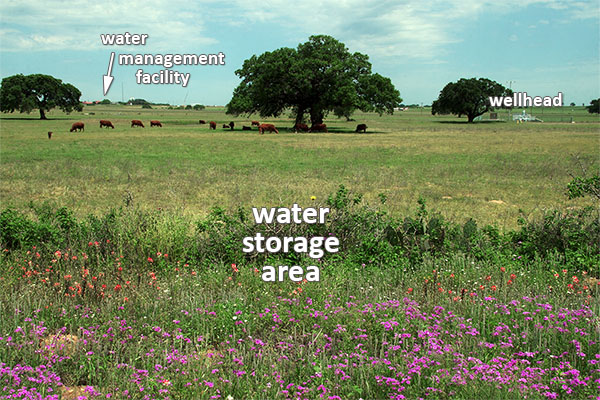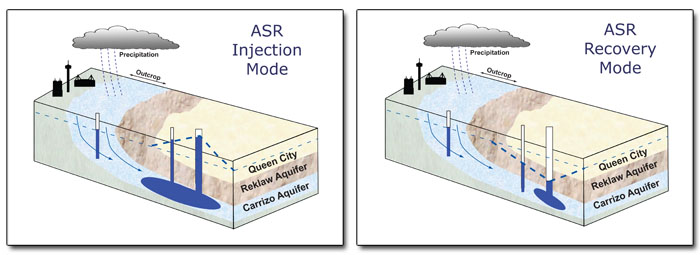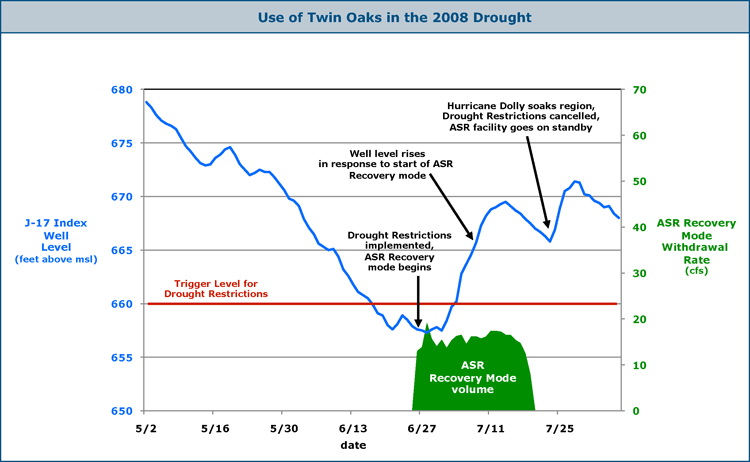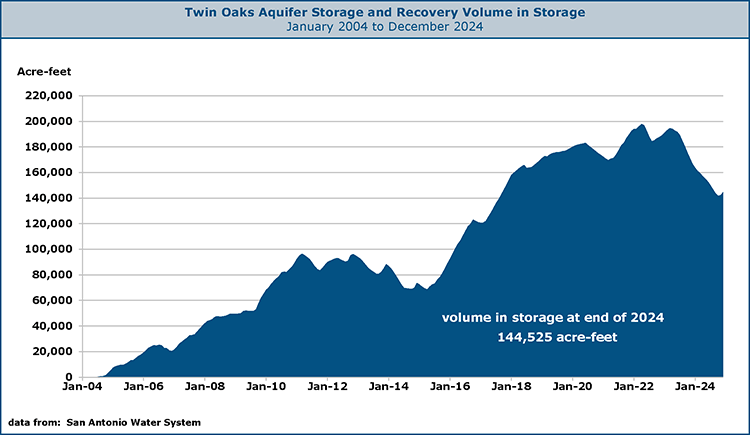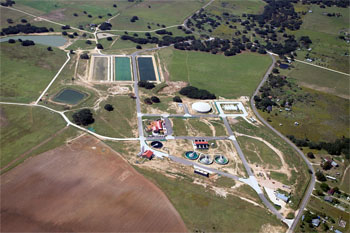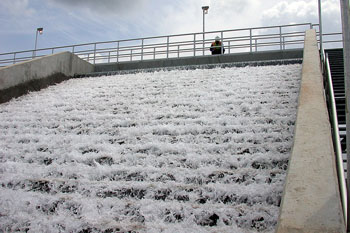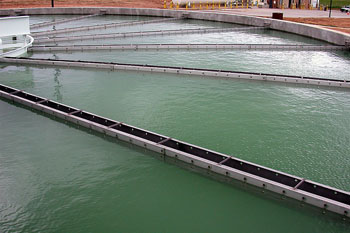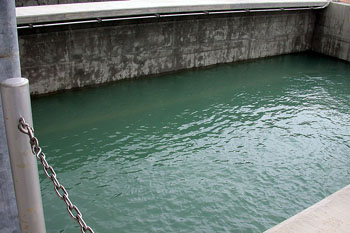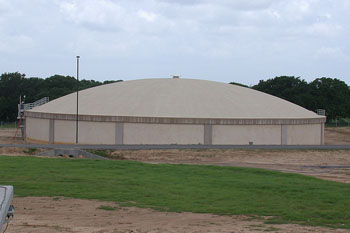
|
|
Aquifer Storage and Recovery Unlike the Edwards Aquifer with its high transmission rates, water in a sand aquifer tends stay in place or move very slowly. Water injected into unconfined sand forms a stationary dome, and if there are confining layers then water spreads out horizontally. Either way, it is possible to store water in sand and come back years later and extract the exact same water. This is the concept behind Aquifer Storage and Recovery (ASR). When there is extra Edwards water around, it can be injected into locally occurring sands and extracted during times of shortage. Water from other sources can also be transported and stored in the sands for later use. ASR technology addresses one of the regionís biggest problems: there is hardly any storage locations where water can be put in times of plenty for later use. ASR offers several big advantage. Storing water underground in sand instead of a reservoir means that no water evaporates and it is protected from contamination. Nobody's land has to be condemned and inundated with water, so the social and environmental impacts are minimal. Also, itís easy to ensure the people who pay for the project are the ones who benefit, which is not necessarily the case with other options such as additional Edwards recharge. ASR technology has been in use for many years on the east coast, in Florida, and in California. In Texas, there are now three operating ASR facilities - one was developed in El Paso in 1985 and injects recycled water, a second was completed in Kerrville for the Upper Guadalupe River Authority in 1995, and the other was built by the San Antonio Water System in south Bexar county and came online in June 2004 (see the Texas Water Development Board's 2011 assessment of ASR facilities in Texas).
When source water is available, it is injected into the Carrizo sand aquifer. The same wells are later used to extract the water and distribute it to users. The water retrieved is the exact same water that was injected, and there is no evaporation. The land overlying the wellfield can also continue to be used for other purposes such as agriculture or grazing. San Antonio Project Development In September 1996 the San Antonio Water System and Bexar Metropolitan Water District were awarded a $200,000 grant to study the possibility of storing water in the Carrizo-Wilcox and Glen Rose aquifers, the saline zone of the Edwards Aquifer, and the Austin Chalk and Anacacho limestone formations (2). The study included looking at availability of water for storage, whether the source waters were compatible with water in the destination aquifers, and the quality and movement of water in each aquifer. The Carrizo-Wilcox Aquifer was identified as having the characteristics necessary for Aquifer Storage and Recovery. The Carrizo-Wilcox is composed mainly of sand interbedded with gravel, silt, clay, and lignite. It extends from the Rio Grande in South Texas northeastward into Arkansas and Louisiana, passing through southern Bexar, Wilson, and Atascosa counties. In some places the water has a high iron content, and hydrogen sulfide and methane also occur. Carrizo water is easily treated by conventional methods, and lots of people currently use it without treatment. In September 1999 the San Antonio Water System purchased a 261 acre farm over the Carrizo-Wilcox near the Atascosa-Bexar county line, and added two more large adjacent tracts in February 2000 for a total of over 3,200 acres (6, 7). SAWS developed an aggressive project timetable to have the facility online and producing water in late 2002 or early 2003, and plans included leaving the farms in agricultural production. In February 2001 the SAWS' Board approved $7.53 million in engineering design contracts to move the project forward (8). Engineers began preparing plans for a facility capable of producing about 30,000 acre-feet of water per year, enough for about 60,000 families. Overall, the project was estimated to cost about $215 million. As initially envisioned, the project was mainly a Carrizo production facility, with less emphasis on storage and recovery. Engineers estimated it could produce 30 million gallons per day of local Carrizo water for about 50 years.
In October 2001, fearing that SAWS' plans to pump water from the Carrizo-Wilcox aquifer would affect their own wells, south Bexar county residents asked to be included in the neighboring Evergreen Underground Water District (10). A small portion of the Carrizo-Wilcox aquifer in Bexar county is not within any groundwater district and therefore not regulated. Inclusion in the District would mean that SAWS could be subject to pumping limitations. On October 30 the Board of the Evergreen District accepted the resident's petition and scheduled a February 2 vote by approximately 8,000 landowners that use the Carrizo-Wilcox. SAWS officials appealed to the Board to delay calling for an election, asking for time to explore a joint management agreement that could provide more protection than regulation. The utility proposed a contract with the District that would provide for mitigation and paying to remedy any problems caused by declining aquifer levels. SAWS would also fund a well monitoring program so that impacts could be measured. Meanwhile, in November of 2001, the utility received a permit from the Texas Natural Resource and Conservation Commission to construct and operate the system (11). In January 2002 SAWS CEO Eugene Habiger indicated that, based on revised projections of future needs and other sources in SAWS' inventory, the most that SAWS would pump from the Carrizo would be 14,000 acre-feet per year, not 30,000 as initially proposed (14). On January 16 the election scheduled for February 2 was halted by a federal judge after a community group filed a lawsuit alleging the election would violate the federal Voting Rights Act because there would be only one voting site (15). The election was cancelled and re-scheduled for May 4 (16). Observers noted that even if voters decided to include the area in the Evergreen Underground Water District, it would not necessarily mean the end of the project. SAWS has an interlocal agreement with the District and the San Antonio River Authority to work together on ASR. The District's board indicated it was not philosophically opposed to ASR, as long as it is proven to be feasible and safe (12). Area residents who opposed the project were worried that pumping of large volumes by SAWS would cause their own wells to decline, and they were also worried about possible chemical reactions from the introduction of Edwards water. SAWS officials conceded that drawdown of wells in the vicinity of the project will occur (9), but they promised that mitigation would include lowering of pumps, deepening of wells or drilling new ones, or the provision of access to potable-water service from a local purveyor. Tests conducted on the feasibility of mixing Carrizo and Edwards water did not reveal any problems or adverse chemical reactions. On February 19, 2002, the SAWS Board adopted a policy stating that in 2004 and 2005 SAWS would take water from the Carrizo only if Stage III drought restrictions were imposed and would take no more than 14,000 acre-feet per year. In April 2002 SAWS revised its policy to say it would draw no more than 28,000 acre-feet over the two years of 2004 and 2005 (17), and that total withdrawals for the five year period from 2003 to 2007 would be no more than 32,000 acre-feet. After 2007, SAWS agreed to an annual Carrizo withdrawal limit of 2 acre-feet per acre of land owned in south Bexar county, which is the same volume limitation typically imposed by groundwater conservation districts on all landowners within their jurisdiction. SAWS had purchased 2,179 acres in southern Bexar county, so it can pump 4,358 acre-feet annually from wells covered by the agreement with Evergreen. On May 4, 2002 south Bexar county voters rejected annexation into the Evergreen Underground Water District by a vote of 348 to 322. Supporters of annexation had argued that inclusion in the District would safeguard their water supply, while opponents countered that inclusion would mean additional regulation and taxes without any benefit. County Commissioner Robert Tejeda said "I think the people that were for the annexation will still be protected." (18). On July 16, 2002 the SAWS Board of Trustees approved $110 million in construction and engineering contracts to build the treatment facility and 29 miles of pipelines and pumps to deliver and integrate the water into the SAWS distribution system (19). A groundbreaking ceremony was held on July 31, construction began on August 1, and the facility opened in June of 2004. By the end of 2006, over 20,000 acre-feet had been stored for later use. This water came in very handy during the drought later that year, when more than 6,400 acre-feet of stored water was produced, deferring Edwards pumping and protecting springflows and endangered species. When the rains returned, the facility went back into recharge mode and began storing excess Edwards waters throughout the very rainy year of 2007. In 2008, drought returned, and the facility was again a key component in maintaining the J-17 index well and springflows. In the graphic below, drought restrictions were declared when the 10-day average of the J-17 reached 660, and H2Oaks went into action, recovering about 20 cubic feet per second of stored Edwards water. Over the next two weeks, the J-17 rose more than 10 feet. It was a hot summer, and when demand began to increase again in mid-Juy, the J-17 began to drop again and SAWS contemplated increasing the H2Oaks withdrawal rate. That proved to be unnecessary when Hurrican Dolly soaked the region on July 25. The J-17 remained above the trigger level for drought restrictions for the rest of the year and H2Oaks returned to recharge mode. The several weeks of operation where the facility helped meet demand in a critical period barely put a dent in the total stored volume, which was about 45,000 acre-feet at that time.
While the ASR facility at H2Oaks Center has already proven its usefulness in deferring Edwards pumping to protect springflows, in 2010 the facility became an even greater component of regional plans to protect federally-listed endangered species that depend on the Edwards Aquifer. In 2007, regional stakeholders began working toward a 2012 legislative deadline to produce a management plan under a process known as the Edwards Aquifer Recovery Implementation Program (EARIP). In 2010 the stakeholders reached a consensus about the elements and financing of the plan. One of the main elements is use of H2Oaks to store excess water for regional partners and hold it for retrieval during droughts. Pumpers will pay higher fees and SAWS will be paid $9.5 million per year to store water for others for retrieval during very severe droughts. The facility was used again in 2011, when the worst one-year drought on record occurred. When demand eased and rains came in the fall of 2011, recharge was resumed and at the end of the year there were almost 88,00 acre-feet in storage, enough to supply all of San Antonio's needs for more than six months. Although rainfall in 2012 was above average, Aquifer levels did not really recover from the previous year, so water was withdrawn from storage during the summer to help maintain springflows. Recharge resumed in the fall and by the end of 2012, there was almost 95,000 acre-feet in storage. Although rainfall in 2013 was about average in San Antonio, much less fell in Edwards Aquifer recharge areas to the west, so Aquifer levels remained relatively low and the H2Oaks plant saw its longest production run since the facility opened. Towards the end of the year, with demand easing and some water left in SAWS' annual allocation, recharge resumed and at the end of the year there was 88,275 acre-feet in storage. By June of 2014, with the drought continuing, production resumed and continued until December, when the facility began storing water leased by the Edwards Aquifer Authority as part of the regional Habitat Conservation Plan for the protection of springflows and endangered species. At the end of 2014 there was 73,527 acre-feet in storage. The drought finally ended in 2015 and a lot of unused Edwards water was available to SAWS, so by the end of 2015 there was 88,897 acre-feet in storage. In March of 2016 the facility achieved the landmark of having 100,000 acre-feet in storage for the first time, which is almost half a year's supply for San Antonio. By December of 2022, the amount was 189,000 acre-feet.
In August of 2007 a feud between Bexar Met and SAWS erupted over Bexar Met's plans to pump water from a wellfield across the street from H2Oaks. Bexar Met had originally planned to pump 5 mgd from the wellfield but announced plans to almost triple that amount, and SAWS contended that modeling analysis indicated such a withdrawal rate would have an impact on H2Oaks "storage bubble" (it is not really a bubble, it's more like a starfish). SAWS Trustee Douglas Leonhard said "I think this is really quite serious. Their pumping has the capability and really quite the certainty of moving that bubble of Edwards water over into the Staggs Ranch area where it can be pumped out by Bexar Met." (20). A year later, in August in 2008, the Bexar Met board voted to downsize their plans to 2.5 mgd, primarily because of cost (21). In 2008, SAWS completed an additional seven wells for the exclusive purpose of gaining access to the 4,358 acre-feet per year of local Carrizo water covered in the 2002 agreement with the Evergeen District. It is not really possible for SAWS to recover its local Carrizo water from the ASR wells because large amounts of Edwards water has been injected into them. The Carrizo wells were placed upgradient from the stored Edwards water in order to reduce the hydrostatic pressure on the Edwards bubble and help to keep it from migrating downgradient and away from the recovery wells. When SAWS was merged with the Bexar Metropolitan Water District in 2012, it acquired Bexar Met's installed capacity to produce another 1,000 acre-feet, giving SAWS access to a total of 7,400 acre-feet of Carrizo water. Early versions of the water plan produced by the South Central Texas Regional Water Planning Group had proposed that regional partners would build another ASR facility in Wilson and Gonzales counties. But at this time, no one has any plans for a second ASR facility in the immediate area, mainly because the storage capacity at H2Oaks has turned out to be much greater than first thought. Initial estimates were that about 22,000 acre-feet of water could be stored. In 2010 a SAWS staffer discovered that consulting engineers had made a rather serious error in their mathematical computations. Their calculated storage volume was incorrect by an order of magnitude. This discovery enabled SAWS to immediately ramp up the storage rate and bank an additional $20 million worth of water in 2010, and it also paved the way for SAWS to offer use of H2Oaks as a regional springflow management strategy in the EARIP plan. The H2Oaks site is also the property on which SAWS completed a desalination project. It produces brackish water from a formation that is deeper than the Carrizo sands, leaving the stored Edwards intact. See the desalination page for a graphic showing the relation of the two formations to the ASR and desalination wells. In light of the great success that SAWS has had at H2Oaks, other cities are now considering similar facilities. In August of 2012 the New Braunfels Utilities board received a feasibility study that concluded it would be possible to construct a facility at the city's airport to store about 7,000 acre-feet of water and provide more than a million gallons per day when needed, about 10% of New Braunfels' 2012 demand. It would be stocked with water from the Guadalupe River and Canyon Lake and would cost about $2 million to develop. The study also outlined a possibility for a second storage site in the northwest section of New Braunfel Utilities' service area (22). In 2016, the city of Buda approved a feasibility study to examine the possibility of storing Edwards water in the Trinity Aquifer. Buda water specialist Brian Lillibridge said "Drought resiliency is one of the huge benefits that ASR can add to an existing water supply. It's especially relevant during a declared drought when our available groundwater is subject to mandatory reductions of up to fifty percent, depending on the severity of the drought. The ability to store a large volume of water to offset pumping reductions is invaluable (23). In 2019, Buda successfully shephered a bill through the Texas Legislature to allow it to pursue a more ambitious water management strategy. In addition to Edwards water, Buda would like to store surface water supplied by the Guadalupe-Blanco River Authority, but an old rule prohibits any water that does not come from the Edwards Aquifer from passing through it, even if it is in a sealed pipe. Buda's plan is to pass a pipe through the Edwards into the underying Trinity. Brian Smith, a hydrologist for the Barton Springs Edwards Aquifer Conservation District, said "This rule goes back quite a ways. It was meant to be extra protective of the Edwards Aquifer, but there were unintended consequences" (24). Senate Bill 483 and its companion House Bill 1044 remedied this situation and was signed by the Governor on June 10, 2019. Also in 2019, the city of New Braunfels moved forward on its ASR plans by activating a demonstration well. Water from the Guadalupe River will be treated before injection underground and treated again when it is recovered. Once completed, New Braunfels expects to have nine ASR wells with a capacity of about nine million gallons per day (25). In April of 2020, Buda moved forward on its ASR project with the drilling of a pilot ASR well. Water Resource Coordinator Blake Neffendorf described the plan: "We will inject a particular amount of water in the Edwards Aquifer into the ASR well. Then we will immediately pull that back out and take samples and test the water quality to see what types of results we're getting back from that first initial extraction. After that is complete we will go into a larger phase and pump in several more million gallons of water into the well, let it sit for a week or so, and then pull it back out and do the same thing and test and make sure we are getting good water quality. Once we get all of our results back, the well has been completed, and we've done all of our samplings, and we've proven that the water quality is safe whenever it is mixed, then TCEQ (Texas Commission on Environmental Quality) will give us final approval. Then we can actually have this as a source that will go into our infrastructure and will go back in here to our Garlic Creek Booster Station" (26). In May of 2022, the city of Austin announced a 20-year project to store 60,000 acre-feet in an ASR facility by 2040. Engineers began analyzing potential sites for the project and hoped to have a site selected by the end of 2023. A pilot program would begin in 2024, and then a design and construction phase with a target for a fully scaled operation by 2035 (27).
The Treatment Process When Edwards water is recovered, it does not require treatment before distribution. The treatment plant portion of the H2Oaks facility is designed to make native Carrizo Aquifer water compatible with Edwards Aquifer supplies. Carrizo water is typically high in iron and manganese and has lower hardness and pH than Edwards water.
|
||||||||||||||||||||||
|
Materials used to prepare
this section: (1) "Aquifers as water tanks?" San Antonio Express-News, July 3, 1996. (2) "$200,000 grant to pay for water storage study" San Antonio Express-News, September 21, 1996. (3) "SAWS mulls using other area aquifers" San Antonio Express-News, October 6, 1996. (4) "SAWS to explore alternate storage" San Antonio Express-News, May 21, 1997. (5) "SAWS has eyes on sand aquifer" San Antonio Express-News, June 17, 1998. (6) "SAWS buys farm for Edwards water storage" San Antonio Express-News, September 1, 1999. (7) "SAWS adding two supply sources" San Antonio Express-News, February 16, 2000. (8) "SAWS approves design contract for reservoir" San Antonio Express-News, February 7, 2001. (9)< "SAWS’ president: Lose the 800-pound gorilla" Wilson County News, September 26, 2001. (10) "SAWS plan alarms neighbors" San Antonio Express-News, October 25, 2001. (11) "State OKs aquifer storage project" San Antonio Express-News, November 11, 2001. (12) "TNRCC authorizes drilling of SAWS’ wells in southern Bexar" Wilson County News, December 5, 2001. (13) "SAWS, BexarMet ganging up on Evergreen district?" Wilson County News, December 26, 2001. (14) "SAWS downsizes south-Bexar plan for aquifer’s pumping" Wilson County News, January 9, 2002. (15) "Federal judge halts southern-Bexar water election" Wilson County News, January 14, 2002. (16) "Election, partly thwarted by bioterrorism, canceled" Wilson County News, January 30, 2002. (17) "SAWS revises Carrizo policy" San Antonio Express-News, April 4, 2002. (18) "Evergreen annexation is rejected" San Antonio Express-News, May 5, 2002. (19) "Water treatment plant on track" San Antonio Express-News, July 17, 2002. (20) "Stored water is focus of fight" San Antonio Express-News, August 8, 2007. (21) "Bexar Met OKs sale of Comal water system" San Antonio Express-News, August 12, 2008. (22) "NBU board receives ASR study findings" New Braunfels Herald-Zeitung, August 30, 2012. (23) "Buda to study feasibility of storing Edwards Aquifer water in the Trinity Aquifer" MercuryNews.com, August 5, 2016. (24) "Buda aquifer storage bill passes in Texas Senate" Community Impact Newspaper, May 24, 2019. (25) "New Braunfels Utilities breaks ground on aquifer storage and recovery well" Community Impact Newspaper, November 11, 2019. (26) "Buda begins drilling its Aquifer Storage and Recovery well" SMCorridorNews.com, April 13, 2020. (27) "Austin Water to announce pilot aquifer storage site by the end of next yearl" Austin Monitor, May 27, 2022. |
||||||||||||||||||||||
